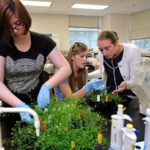UMW junior Lindsey Jones is tackling tuberculosis. Sophomore Ave Keefer is working to turn carbon dioxide into something useful. Senior Hoang-Anh Tran is exploring the harmful components in plastic.
- UMW student Brandon Rozek participated in UMW’s 2017 Summer Science Institute, which pairs students and professors on intense research projects. Photo by Norm Shafer.
- UMW student Grace Percival works on a research project for the physics department during the Summer Science Institute. Photo by Norm Shafer.
- From left, UMW junior Renee Hilelson and senior Rachel Evans work with Assistant Professor of Biology April Wynn on a research project involving genetic testing of plants during the Summer Science Institute. Photo by Norm Shafer.
The projects, part of the University of Mary Washington’s Summer Science Institute (SSI), have students and professors working together on promising research. Focused on critical issues like anxiety and depression, water and soil contamination, and the vitality of plants, SSI turns the typical two-hour lab on its head. Undergraduates take the lead on STEM-based projects that prepare them for careers and grad schools, with the potential to shape not only their own futures but everyone else’s.
“They get to devote so much time to their projects,” said Professor of Chemistry Nicole Crowder, who co-directs the program with Professor of Biology Abbie Tomba. “It shows them what being a research scientist looks like. They learn what it would be like to do that on a daily basis.”
The 10-week program, a partnership between UMW’s earth and environmental science, chemistry, biology, physics, math and computer science departments, runs May through July and ends in a daylong public symposium, where students present their findings.
“There are some really fascinating projects this summer,” Crowder said. “I’m excited to see what they figured out.”
For some, like senior geology major Abby Friedman, SSI provides a first taste of real, original research. With her partner, junior environmental science major Sarah Jordan, Friedman scoured Fredericksburg parks, golf courses and buildings for toxins like pesticides, arsenic and lead that could seep into drinking water. They used scientific techniques like inductively coupled plasma spectroscopy and high-performance liquid chromatography to test soil samples and identify contaminants that could harm the environment.
“It’s mind-blowing for me,” Friedman said. “I’ve learned a lot of things I didn’t know you could do and test for.”
Eleven faculty members mentored 20 students through this summer’s SSI session, which includes workshops, team-building extracurricular activities and weekly meetings to monitor progress.
Jones, the junior whose research centers on tuberculosis, is working to further Assistant Professor of Chemistry Davis Oldham’s quest to discover a new drug to treat the contagious bacterial disease.
“I’m applying everything I learned in organic chemistry over the past year,” she said.
Jones called the time and attention she’s received from her professor “invaluable,” and Oldham agrees.
“It’s a win-win situation,” he said. “There’s no better teacher than experience, and the students are better scientists as a result.”
Junior Renee Hilelson and senior Rachel Evans teamed up with Assistant Professor of Biology April Wynn. They extracted plant DNA to study the aintegumenta (or “ANT”) gene, which controls cell division, to explore responses to harsh climate conditions, like drought and cold temperatures.
Professor of Chemistry Ray Scott obtained a grant from DuPont in 1999 to start the SSI. The program originally spanned the sciences – biology, chemistry, physics, and earth and environmental science – and expanded in 2004 to include math and computer science. Students who complete the intensive research experience often go on to present their findings at national conferences, graduate with honors and get into great grad schools.
“I came to Mary Washington because I wanted to teach,” Crowder said. “One of the most effective ways we can teach is to give students an opportunity to do real research.”


